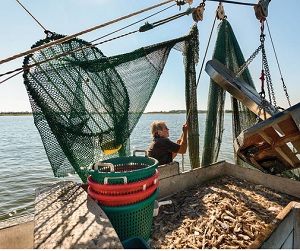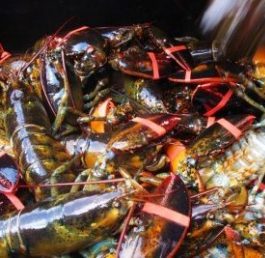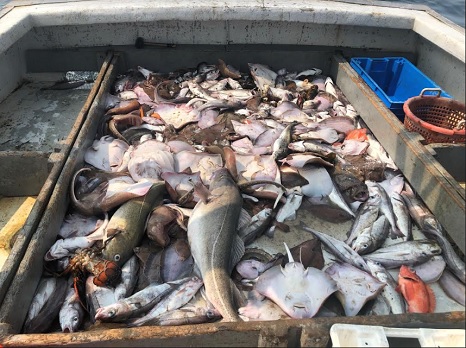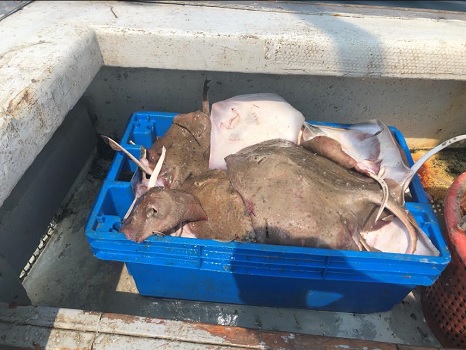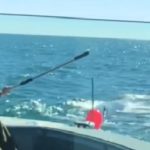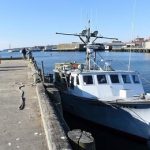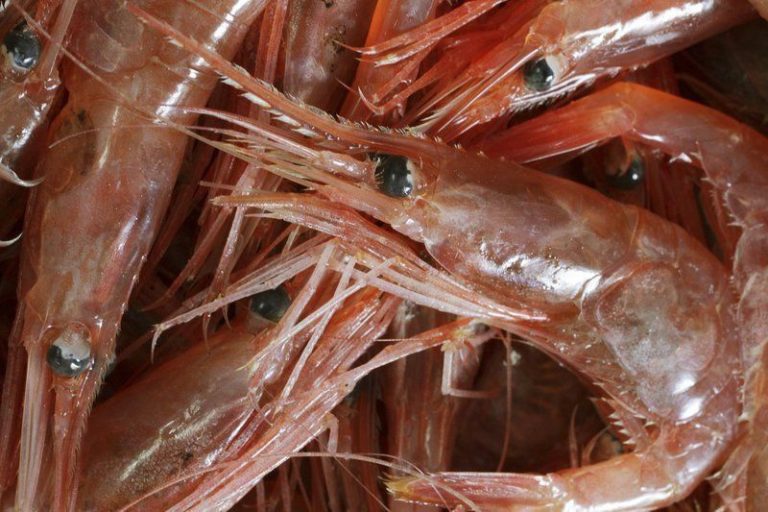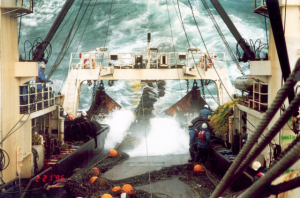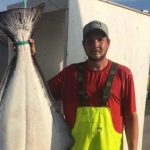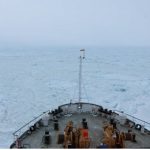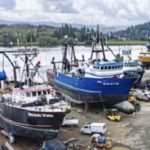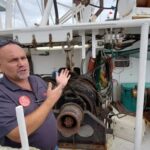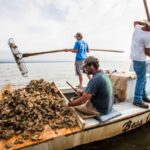Search Results for: Orin C
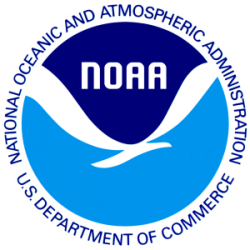
Notice Regarding Loss of Vessel Monitoring Service
The McMurdo (formerly Boatracs) Omnitracs Vessel Monitoring System (VMS) operated by vessels with Greater Atlantic Region (GAR) permits will not be supported by its satellite provider after March 31, 2020. All current owners of the Omnitracs unit were notified via a letter from McMurdo dated December 19, 2019 about this issue. What should you know if you own an Omnitracs unit? >click to read< 10:27
Notice Regarding Loss of Vessel Monitoring Service
The McMurdo (formerly Boatracs) Omnitracs Vessel Monitoring System (VMS) operated by vessels with Greater Atlantic Region (GAR) permits will not be supported by its satellite provider after March 31, 2020. All current owners of the Omnitracs unit were notified via a letter from McMurdo dated December 19, 2019 about this issue.
What should you know if you own an Omnitracs unit?
This VMS unit must be replaced by April 1, 2020 or risk being out of compliance with VMS requirement regulations. The unit will not function with any other satellite provider.
A list of current Type-Approved VMS Units is available online.
Within the GAR, current Type-Approved units include:
Addvalue iFleetONE (***Newly Type-Approved)
SkyMate I1500 VMS
SkyMate m1600 VMS
Woods Hole Group – Triton Advanced
While McMurdo has a replacement unit called Omnicom that functions with the Iridium satellite network, this VMS unit is not yet approved for use in the GAR.
Vessel owner/operators with questions about their current service or the new Omnicom unit should contact McMurdo directly at 800-262-8722 or by email.
What is the status of Type-Approval of the replacement McMurdo unit?
We are working with McMurdo to test their new Omnicom VMS so that we can recommend it for approval. However, we cannot say how long this process will take, but have made review of this unit a priority.
VMS Reimbursement Guidance
Reimbursement is available for the purchasing of a new VMS unit if a vessel owner has never been reimbursed by NOAA for the purchase of a VMS unit. If a vessel owner has previously been reimbursed for the cost of a unit for that vessel, reimbursement is not available.
Vessel owner/operators with questions on NOAA’s VMS reimbursement program or their eligibility for VMS reimbursement should contact the OLE Helpdesk at 888-219-9228 or by email, http://[email protected]
VMS Power Down Guidance
Vessels that will not be actively fishing in the near future may request an exemption to have the VMS powered off until they are ready to replace the VMS. Vessels should not operate with a non-compliant VMS. Vessels that operate without an approved VMS could face enforcement action.
All vessels that hold VMS required permits cannot power the unit off unless they are on an authorized power down. Owners may request from the Northeast VMS Team to have the VMS powered off. Once a request is received, the Northeast VMS Team will issue a Letter of Exemption (LOE) that will authorize the VMS to be powered off.
Regulations implementing the requirements for the vessel monitoring system (VMS) within the Greater Atlantic Region allow for vessels to be exempt from the requirement to transmit the vessel’s location at all times if one or more of the following conditions are met:
The vessel will be continuously out of the water for more than 72 consecutive hours; or
A vessel with a valid multispecies limited access, scallop limited access, mackerel limited access, surfclam/ocean quahog, herring, longfin squid/butterfish moratorium or illex squid moratorium permit (only) remains at the dock/mooring and does not engage in any fisheries for a minimum period of 30 consecutive days.
Vessels that only hold an LAGC scallop permit for their VMS requirement may submit the Power Down declaration directly with their VMS unit and do not require an LOE.
General VMS Questions?
Contact: the Northeast VMS Team at 978-281-9213

Family Fishermen Challenge Illegal, Industry-Killing At-Sea Monitoring Rule from Department of Commerce
Cause of Action Institute (“CoA Institute”) today filed a lawsuit on behalf of a group of New Jersey family fishermen to block a new regulation that would force them to pay for third-party “at-sea monitors.” The industry-killing rule—which was designed by the New England Fishery Management Council and promulgated by the National Oceanic and Atmospheric Administration and U.S. Department of Commerce—will require certain boats in the Atlantic herring fishery to carry “at-sea monitors” and at their own cost. >click to read< 14:40

NOAA Announces 2020 At-Sea Monitoring Coverage Levels for Groundfish Sector Fishery
NOAA announces that for fishing year 2020, the total target at-sea monitoring coverage level is 40 percent of all groundfish sector trips subject to the at-sea monitoring program. For more information, please read our letter to the New England Fishery Management Council and the Summary of Analysis Conducted to Determine At-Sea Monitoring Requirements for Multispecies Sectors FY 2020. >click to read< 15:27
NOAA Fisheries Announces 2020 At-Sea Monitoring Coverage Levels for Groundfish Sector Fishery
January 28, 2020
NOAA Fisheries announces that for fishing year 2020, the total target at-sea monitoring coverage level is 40 percent of all groundfish sector trips subject to the at-sea monitoring program. For more information, please read our letter to the New England Fishery Management Council and the Summary of Analysis Conducted to Determine At-Sea Monitoring Requirements for Multispecies Sectors FY 2020.
Per direction in 2020 appropriations, we have funds allocated for reimbursing industry for its at-sea monitoring costs. The Atlantic States Marine Fisheries Commission will continue to administer the reimbursement program for 2020 as in prior years.
Questions?
Fishermen: Contact Mark Grant, Regional Office, 978-281-9145
Media: Contact Allison Ferreira, Regional Office, 978-281-9103
Letter to the New England Fishery Management Council
Dr. John Quinn Chairman New England Fishery Management Council 50 Water Street Mill 2 Newburyport, MA 01950
Dear John:
UNITED STATES DEPARTMENT OF COMMERCE National Oceanic and Atmospheric Administration NATIONAL MARINE FISHERIES SERVICE GREATER ATLANTIC REGIONAL FISHERIES OFFICE 55 Great Republic Drive Gloucester, MA 01930-2276
JAN 2 8 2020
The total combined target level of at-sea monitoring (ASM) coverage required for Northeast multispecies sectors in fishing year 2020 will be 40 percent of all sector trips subject to the at-sea monitoring program.
NOAA’s National Marine Fisheries Service is required to determine ASM coverage levels that are “sufficient to at least meet the coefficient of variation specified in the Standardized Bycatch Reporting Methodology at the overall stock level for each stock of regulated species and ocean pout, and to monitor sector operations, to the extent practicable, in order to reliably estimate overall catch by sector vessels [emphasis added] (50 C.F.R. § 648.87(b)(l)(v)(B)(l)(i)).” When we make this determination, the regulations require that we take into account “the primary goal of the at-sea/electronic monitoring program to verify area fished, as well as catch and discards by species and gear type, in the most cost-effective means practicable.” The regulations also require that we consider the “equally-weighted secondary goals and objectives of groundfish monitoring programs detailed at § 648.11 (1), the National Standards and requirements of the MagnusonStevens Fishery Conservation and Management Act, and any other relevant factors.” Two federal district court decisions upheld these regulations, with the judge specifically noting that these goals and objectives are consistent with our Magnuson-Stevens Act requirement to ensure catch accountability. In one case, the judge pointed out that we are “obligated to consider the goals of the program-including improving documentation of catch- when setting coverage levels at or above the bare minimum set by the CV [coefficient of variation] standard.” Oceana v. Pritzker, 26 F.Supp.3d 33, 47 (D.D.C.2014). Improving catch documentation includes determining sector total catch and achieving a coverage level sufficient to minimize the effect of any potential monitoring bias. I considered all of these requirements to determine this year’s coverage level.
Our annual analysis to determine the level of ASM coverage required to estimate discards for each northeast multispecies stock with no greater than a 30-percent CV calculated a minimum target coverage level of 32 percent of all groundfish sector trips, based on Georges Bank winter flounder. A summary of that analysis is enclosed and is available at (https://go.usa.gov/xdaKc). In addition to the CV analysis, we also considered four analyses of bias developed by the Groundfish Plan Development Team (PDT) and the peer review by a sub-panel of the Council’s Scientific and Statistical
Committee (SSC). The SSC sub-panel concluded:
(T)he set of studies provide substantial support to conclude that there are differences both in discarding behavior and in fishing behavior between observed and unobserved trips. The analyses suggest that discard estimates from observed trips should not be used to estimate discards from unobserved trips, or at minimum not without some adjustments. In addition, this suggests it is not appropriate to determine a level of observer coverage that should be deployed by considering the coefficient of variation of discard estimates from observer coverage since observed trips are not representative of unobserved trips.
Given the PDT’s work and the conclusions of the SSC sub-panel, I am concerned it would be inappropriate to base the fishing year 2020 target coverage solely on the results of the CV analysis. Consistent with the regulations and the Court’s ruling in Oceana v. Pritzker, I have determined that coverage needs to be increased above the minimum coverage necessary to achieve a CV30 in order to address their conclusions. Consistent with the requirement to monitor sector operations and to reliably estimate overall catch to the extent practicable, I am setting the coverage target level at 40 percent.
Setting the coverage target level at 40 percent takes into account what may practicably be achieved in the next fishing year while the Council continues to develop Amendment 23 and address the issues raised by the bias analyses and the associated peer review. A 40-percent coverage target is also consistent with the other goals and objectives of the monitoring program, including improving documentation of catch. The PDT’s on-going work and the SSC subpanel’s conclusions make it clear that the coverage level must incorporate more than the CV30 analysis standard. There is still critical development and analysis required to determine the coverage level and other measures that may be necessary to address bias over the long term and other issues identified before Amendment 23 is completed. Attempting to develop a new method for calculating the necessary coverage for 2020 while the Council continues development of Amendment 23 would be impractical and inappropriate, and I want to avoid predetermining the Council’s decisions ahead of further development, analysis, and public participation. There are also many implementation concerns with large increases in coverage that we must take into account. After evaluating our ability to scale up coverage in collaboration with monitoring providers, I have determined that 40-percent coverage is the most practicable for fishing year 2020. As we have seen, it takes time for the agency, monitoring providers, and industry members to ramp up coverage levels. Accordingly, the 40-percent target represents an achievable increase.
I am announcing my determination now to allow time for us to prepare to support increased coverage, for monitoring providers to ensure sufficient staff, for sectors to work with providers to contract service, and for industry members to make decisions for fishing year 2020. We expect to continue to have funding available to reimburse industry for their at-sea monitoring costs in fishing year 2020.
2
If you have further questions about the fishing year 2020 ASM coverage target, please contact Sarah Heil, Assistant Regional Administrator for Sustainable Fisheries, at (978) 281-9257.
Sincerely, Michael Pentony r P ~ n J :~ Regional Administrator
SUMMARY OF ANALYSES CONDUCTED TO DETERMINE AT-SEA MONITORING REQUIREMENTS FOR MULTISPECIES SECTORS FY2020,
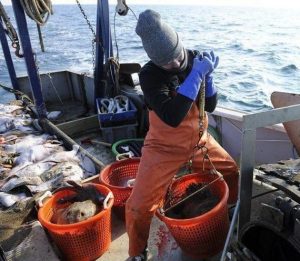
Northeast Seafood Coalition questioning the NEFMC fish monitoring regulation process
The New England Fishery Management Council is set to resume action on the contentious groundfish monitoring amendment next week, but the Gloucester-based Northeast Seafood Coalition is questioning whether the council is rushing its own process and operating with incomplete information. The council, scheduled to meet for three days next week in Portsmouth, New Hampshire, will return Wednesday to the arduous task of completing Amendment 23, which will set monitoring levels for vessels operating within the Northeast multispecies groundfish fishery. >click to read< 13:36
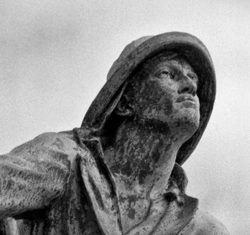
Fishermen look to DC delegation for aid, Fish bill like farm bill touted, but monitoring costs biggest concern
Former fisherman Sam Parisi appeared before the city Fisheries Commission on Thursday night to tout his campaign for national legislation to help fishermen as the federal Farm Bill helps farmers. “We need someone to draft a fish bill like the farm bill,” Parisi told the commission members at City Hall.,, The commission members, in the end, decided the best course is to work with Mayor Sefatia Romeo Theken to set up a meeting — a fish summit of sorts,,, >Click to read< 13:06
December 15, 2017 – Lets meet and build a consensus to have Congress enact a U.S. Fisheries Bill – Sam Parisi >click to read Sam Parisi’s posts<
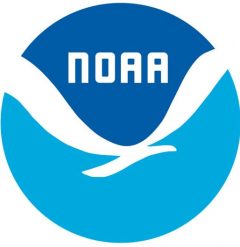
N.E., Mid Atlantic-Vessel Monitoring System Software Update Required for Vessel Owners
The VMS unit installed on your vessel requires a software update to comply with recent regulatory changes and prepare for potential measures that still must be approved before going into effect. Depending on your vendor, the new software will be released and available on November 25, 2019 (SkyMate and Woods Hole Group), or will update automatically on November 25, 2019 (McMurdo). Begin using this new software for trips after December 6, 2019. Bulletins with additional information have been mailed and are also available on our >website<. Questions? Contact: Sustainable Fisheries, (978) 281-9315 or Northeast VMS Team, (978) 281-9213
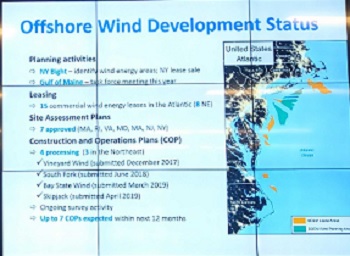
‘A Whole New Industry’: N.H. To Work With Neighboring States On Offshore Wind in Gulf of Maine
New Hampshire, Maine and Massachusetts will work together on large-scale offshore wind development in the Gulf of Maine. Stakeholders from the three states met today in Manchester talk about the possibilities and obstacles for that new industry. The event was hosted by the Environmental Business Council of New England at the state headquarters of Eversource, which is developing several large offshore wind projects elsewhere in the Northeast. >click to read< 14:06
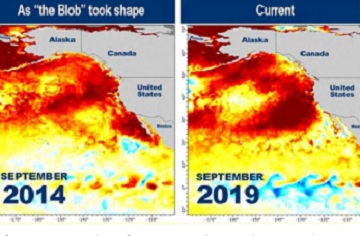
Scientists monitoring new marine heat wave off B.C. coast similar to ‘the Blob’
The swath of unusually warm water stretches roughly from Alaska down to California, according to NOAA in the United States. The marine phenomenon began in the Gulf of Alaska sometime around June 15 and ballooned over the summer.Officials tracking the system said it is already the second-largest experts have seen since 1981 — the first year for which satellite data used to track marine heat waves is available. “Already, on its own, it is one of the most significant events that we’ve seen,” Andrew Leising, a research scientist at the NOAA’s Southwest Fisheries Science Center in La Jolla, Calif., said in a statement Thursday. >click to read< 19:37
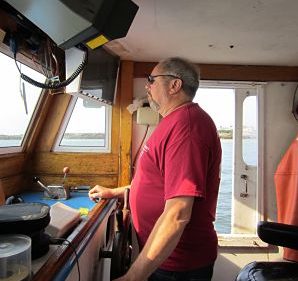
100% fishing monitoring is unnecessary, David Goethel
I would like to correct some misconceptions and rebut some of the statements made by Ms. Johanna Thomas in her Aug. 2, 2019 opinion, Monitoring will help improve New England’s fisheries. >click to read< Ms. Thomas sites the West coast Groundfish fleet as a success story. That is not the case as told by the fishermen on the West coast. She also fails to mention that 50% of the fleet was bought out in a $60 million-plus dollar buy out prior to the implementation of catch shares. This alone should have rebuilt stocks. >click to read< 21:28
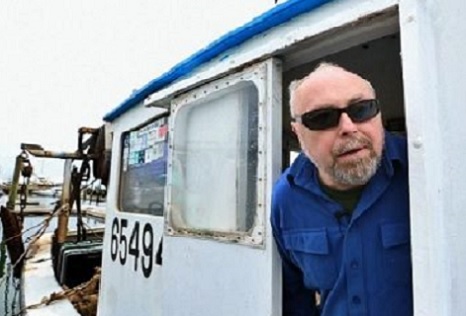
UPDATED: The hidden cost of fishery monitoring
Recently my crewman came into the wheelhouse with a complaint. I am a commercial fisherman and we were on our third consecutive day of carrying at-sea monitors, which we are required to do in 2019 on at least 31% of trips. This is like having your own state policeman ride with you to work to make sure you do not exceed the speed limit. They watch you to make sure you do not throw over any fish that are part of your quota. Because the government wants their monies worth, they have them weigh everything you bring on board. By David Goethel >click to read< 18:41 Dave sent these photo’s which were not included in the article.
100% fishing monitoring is unnecessary, David Goethel
August 13, 2019
I would like to correct some misconceptions and rebut some of the statements made by Ms. Johanna Thomas in her Aug. 2, 2019 opinion, Monitoring will help improve New England’s fisheries. >click to read< Ms. Thomas sites the West coast Groundfish fleet as a success story. That is not the case as told by the fishermen on the West coast. She also fails to mention that 50% of the fleet was bought out in a $60 million-plus dollar buy out prior to the implementation of catch shares. This alone should have rebuilt stocks. >click to read< 21:28
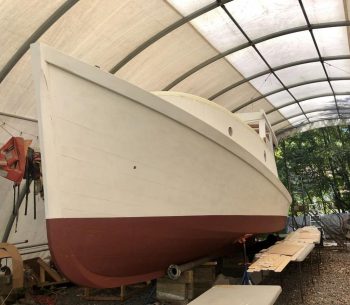
Saving Sylvia II: The story of restoring a historic wooden boat from NC
An old wooden boat built in 1934 is less than three months away from being fully restored and tying up in the water on Shem Creek.,, “These fishing villages, like Mount Pleasant used to be, are slowly disappearing and dying. And the boats are dying with them,” he said. A short while later, Graham was skimming through a magazine called Wooden Boat. He flipped to the last page of the publication titled “Save a Classic” to browse the wooden boats for sale and laid eyes on Sylvia II, a core fishing sound boat in Morehead City, N.C. Photo’s, >click to read< 09:24

“Just put me down as Luke’s best friend,” – Honoring Everyone’s Best Friend at Fluke for Luke Tournament
More than 400 people registered to fish in the third annual Fluke for Luke tournament, the two-day fishing derby that commemorates the life of Luke Gurney, the beloved Island fisherman who died in a tragic fishing accident in June 2016. Many identified themselves as commercial fishermen hailing from the Island and along the Cape. All of them, however, defined themselves primarily as “a friend of Luke.” Each friend had a different story to share about Luke. Throughout those stories, two recurring themes emerged: his love for fishing and his love for helping others. Photo’s, >click to read<18:28
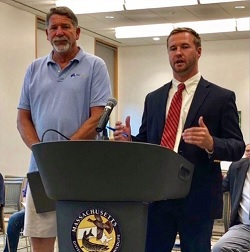
Rep. Patrick Kearney sponsoring three bills for Massachusetts’ fishing industry
State Rep. Patrick Kearney is sponsoring three bills aimed at helping the state’s commercial fishing and lobster industries. Kearney testified in support of the three bills, H814, H815 and H816, at a hearing on Tuesday, June 25. The first, H814, seeks to keep lobster fishing open year round,,, “It’s a false choice between being environmentally friendly and being in support of the lobster industry that supports thousands of jobs here in Massachusetts,” he said. “Despite all the fear-mongering about whales being harmed regularly by Massachusetts lobster traps, our lobster industry has taken steps over a 20-year period, at its own expense, to be environmentally conscious. >click to read< 14:04

MacArtney Lobster Monitoring Tech for SLU
In 2009, MacArtney supplied SLU with a camera and light system that utilised direct telemetry and standard cabling for the original Lobster Sledge. A decade later MacArtney is still collaborating with SLU and has completed the co-design of the Lobster Sledge upgrade that incorporates an HD camera, LED lights, fibre optic multiplexer and interfaces. The system, designed to be towed along the seabed, collects data on the current lobster population. The data collected monitors the lobster population and informs fishing quotas for the southern coast of Norway and the Swedish coast. >click to read<08:44
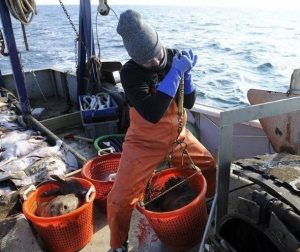
Groundfishermen not hooked by monitoring alternatives
For more than two years, the New England Fishery Management Council has worked on an intricate groundfish monitoring amendment that could have wide-scale economic and regulatory consequences for groundfishermen. It has been a thorny, winding path that involves a host of groundfish committees, plan development teams and assorted staff within the far-flung fisheries regulatory landscape. Now a group of groundfishermen are weighing in. And they are not pleased. >click to read<07:53
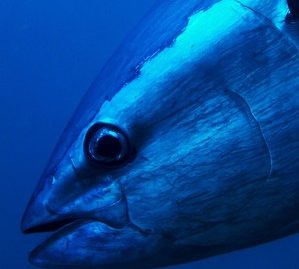
Exploring Potential Changes in Bluefin Tuna Management
NOAA Fisheries announces the availability of a scoping document on Amendment 13 to the 2006 Consolidated Atlantic Highly Migratory Species Fishery Management Plan and our intent to prepare an environmental analysis under the National Environmental Policy Act. Issues and options paper The issues and options paper explores management options with a focus on: Refining the Individual Bluefin Quota Program. Reassessing share distribution and allocation of bluefin tuna quotas, including the potential elimination or phasing out of the Purse Seine category. Other regulatory provisions regarding the directed and incidental bluefin fisheries. >click to read<11:19
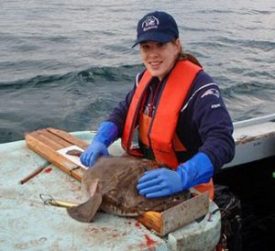
New England Fishery Management Council explores monitoring alternatives
The New England Fishery Management Council continues to work on an amendment to improve monitoring within the groundfish fishery, with a particular emphasis on generating more options within the dockside monitoring alternatives. Meeting for three days this week in Mystic, Connecticut, the council approved several additions and modifications to the original range of groundfish monitoring alternatives, with an eye toward completing a draft environmental impact statement in time to schedule public hearings later this year. The council also requested its Groundfish Committee “expand the number of options,,, >click to read<08:26
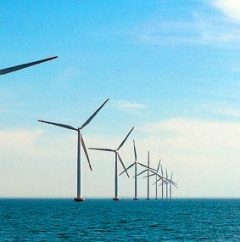
Vineyard Wind to Implement UMass Dartmouth’s Fisheries Monitoring Studies
Vineyard Wind announced today that it will implement recommendations from the University of Massachusetts Dartmouth’s School for Marine Science and Technology (SMAST) to guide the project’s fisheries monitoring studies during construction, as well as to initiate longer-term studies as part of a regional approach to fisheries studies. SMAST’s recommendations were based on its expertise as a leading fisheries research center as well input from active fishermen, government agencies, and academia. >click to read<18:31

At-Sea Monitoring 2019 Coverage Levels and Reimbursement for Groundfish Sector Fishery
NOAA Fisheries announces that for fishing year 2019 the total target at-sea monitoring coverage level is 31 percent of all groundfish sector trips. Additionally, for fishing year 2019, NOAA Fisheries will continue to reimburse 100 percent of industry’s at-sea monitoring costs. In 2018 and 2019, we received Congressional appropriations that have been and will continue to be used to reimburse sectors for 100 percent of their ASM costs. This reimbursement will continue at 100 percent for the 2019 fishing year. As in past years, the Atlantic States Marine Fisheries Commission will administer the reimbursement. For more information, >click to read<15:44

Interior B.C. historical society restoring 90-year-old Japanese-Canadian boat
The Merriwake fishing boat first hit the water 90 years ago near Prince Rupert, B.C. The gillnetter built by master boat-maker Isamu Matsumoto belonged to a Japanese-Canadian fisherman. However, it was confiscated from him in 1942 when he and 22,000 other Japanese-Canadians were forced into internment camps during the Second World War. Today, the Slocan Valley Historical Society is trying to raise between $20,000 and $30,000 to restore the boat to display it on a permanent dry dock near the village of Slocan in the West Kootenay region. >click to read<17:10
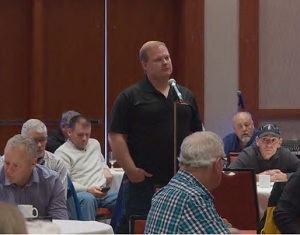
P.E.I. fishermen exploring compensation if damage done to fisheries
The Prince Edward Island Fishermen’s Association is exploring ways members could be compensated if damage is done to local fisheries. The topic was on the agenda for the association’s annual general meeting Saturday. The group has been working with law students at the University of New Brunswick to research different compensation packages in the event of environmental damage. >click to read<

Clearwater pulls plug on storing lobster traps at sea
North America’s largest shellfish producer, Halifax-based Clearwater Seafoods, says it has stopped storing lobster traps at sea. Clearwater’s practice of leaving thousands of pots on the ocean floor for weeks at a time earned it a conviction for a “gross violation” of Canadian fishery rules. Unlike every other lobster fishery, there is no season and Clearwater has been awarded a quota of 720 tonnes, which it says represents about 15 percent of all lobster it sells. >click to read<12:58
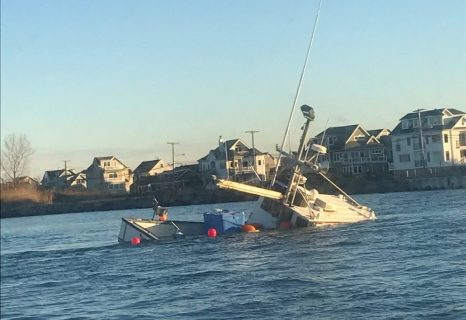
Coast Guard monitoring salvage of partially-sunken vessel in Manasquan Inlet, NJ
The Coast Guard is monitoring the salvage of a partially-sunken commercial fishing vessel in Manasquan Inlet, New Jersey, Saturday morning. Watchstanders in the Coast Guard Sector Delaware Bay command center received notification at 2 a.m. that the 44-foot fishing vessel Miss Kathleen allided with the northern Manasquan Inlet jetty and was taking on water with three people and a dog aboard. The Miss Kathleen’s captain intentionally grounded the vessel on Dog Beach, about 20 yards outside the channel. >click to read<16:09
Coast Guard monitoring salvage of partially-sunken vessel in Manasquan Inlet, NJ
U.S. Coast Guard 5th District PA Detachment Atlantic City
Contact: Coast Guard PA Detachment Atlantic City
Office: (609) 813-3888
After Hours: (757) 434-6043
PA Detachment Atlantic City online newsroom
The Coast Guard is monitoring the salvage of a partially-sunken commercial fishing vessel in Manasquan Inlet, New Jersey, Saturday morning.
Watchstanders in the Coast Guard Sector Delaware Bay command center received notification at 2 a.m. that the 44-foot fishing vessel Miss Kathleen allided with the northern Manasquan Inlet jetty and was taking on water with three people and a dog aboard.
The Miss Kathleen’s captain intentionally grounded the vessel on Dog Beach, about 20 yards outside the channel.
A Coast Guard 29-foot Response Boat-Small crew from Station Manasquan Inlet launched but could not transit the shallow water to reach the fishing vessel. A Manasquan Fire Department boat crew responded, took aboard the three men and dog, then transferred them to the Coast Guard boat crew.
The RB-S crew brought the men and dog to the station. There were no reported injuries.
At 7 a.m., TowBoatUS personnel arrived on scene and secured boom around the Miss Kathleen as a precaution. There are reportedly 800 gallons of diesel on board the vessel, but no signs of sheen or pollution in the water.
“The Coast Guard is working with the New Jersey Department of Environmental Protection to mitigate the environmental threat posed by the sunken vessel,” said Capt. Scott Anderson, commander, Sector Delaware Bay.
-USCG-






